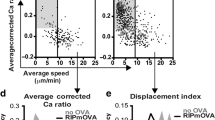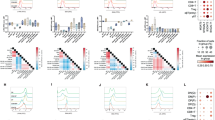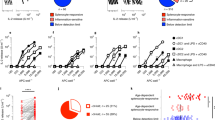Abstract
Positive selection of diverse yet self-tolerant thymocytes is vital to immunity and requires a limited degree of T cell antigen receptor (TCR) signaling in response to self peptide–major histocompatibility complexes (self peptide–MHCs). Affinity of newly generated TCR for peptide-MHC primarily sets the boundaries for positive selection. We report that N-glycan branching of TCR and the CD4 and CD8 coreceptors separately altered the upper and lower affinity boundaries from which interactions between peptide-MHC and TCR positively select T cells. During thymocyte development, N-glycan branching varied approximately 15-fold. N-glycan branching was required for positive selection and decoupled Lck signaling from TCR-driven Ca2+ flux to simultaneously promote low-affinity peptide-MHC responses while inhibiting high-affinity ones. Therefore, N-glycan branching imposes a sliding scale on interactions between peptide-MHC and TCR that bidirectionally expands the affinity range for positive selection.
This is a preview of subscription content, access via your institution
Access options
Subscribe to this journal
Receive 12 print issues and online access
$209.00 per year
only $17.42 per issue
Buy this article
- Purchase on Springer Link
- Instant access to full article PDF
Prices may be subject to local taxes which are calculated during checkout






Similar content being viewed by others
References
Starr, T.K., Jameson, S.C. & Hogquist, K.A. Positive and negative selection of T cells. Annu. Rev. Immunol. 21, 139–176 (2003).
Morris, G.P. & Allen, P.M. How the TCR balances sensitivity and specificity for the recognition of self and pathogens. Nat. Immunol. 13, 121–128 (2012).
Gallo, E.M. et al. Calcineurin sets the bandwidth for discrimination of signals during thymocyte development. Nature 450, 731–735 (2007).
Parsons, S.A. et al. Genetic loss of calcineurin blocks mechanical overload-induced skeletal muscle fiber type switching but not hypertrophy. J. Biol. Chem. 279, 26192–26200 (2004).
Li, Q.J. et al. miR-181a is an intrinsic modulator of T cell sensitivity and selection. Cell 129, 147–161 (2007).
Staton, T.L. et al. Dampening of death pathways by schnurri-2 is essential for T-cell development. Nature 472, 105–109 (2011).
Fischer, A.M., Katayama, C.D., Pages, G., Pouyssegur, J. & Hedrick, S.M. The role of erk1 and erk2 in multiple stages of T cell development. Immunity 23, 431–443 (2005).
Alberola-Lla, J., Forbush, K.A., Seger, R., Krebs, E.G. & Perlmutter, R.M. Selective requirement for MAP kinase activation in thymocyte differentiation. Nature 373, 620–623 (1995).
Wang, D. et al. Tespa1 is involved in late thymocyte development through the regulation of TCR-mediated signaling. Nat. Immunol. 13, 560–568 (2012).
Daniels, M.A. et al. Thymic selection threshold defined by compartmentalization of Ras/MAPK signalling. Nature 444, 724–729 (2006).
Fu, G. et al. Themis sets the signal threshold for positive and negative selection in T-cell development. Nature 504, 441–445 (2013).
Artyomov, M.N., Lis, M., Devadas, S., Davis, M.M. & Chakraborty, A.K. CD4 and CD8 binding to MHC molecules primarily acts to enhance Lck delivery. Proc. Natl. Acad. Sci. USA 107, 16916–16921 (2010).
Van Laethem, F. et al. Lck availability during thymic selection determines the recognition specificity of the T cell repertoire. Cell 154, 1326–1341 (2013).
Trobridge, P.A., Forbush, K.A. & Levin, S.D. Positive and negative selection of thymocytes depends on Lck interaction with the CD4 and CD8 coreceptors. J. Immunol. 166, 809–818 (2001).
Demetriou, M., Granovsky, M., Quaggin, S. & Dennis, J.W. Negative regulation of T-cell activation and autoimmunity by Mgat5 N-glycosylation. Nature 409, 733–739 (2001).
Grigorian, A., Mkhikian, H. & Demetriou, M. Interleukin-2, interleukin-7, T cell-mediated autoimmunity, and N-glycosylation. Ann. NY Acad. Sci. 1253, 49–57 (2012).
Mkhikian, H. et al. Genetics and the environment converge to dysregulate N-glycosylation in multiple sclerosis. Nat. Commun. 2, 334 (2011).
Lee, S.U. et al. N-glycan processing deficiency promotes spontaneous inflammatory demyelination and neurodegeneration. J. Biol. Chem. 282, 33725–33734 (2007).
Chen, I.J., Chen, H.L. & Demetriou, M. Lateral compartmentalization of T cell receptor versus CD45 by galectin-N-glycan binding and microfilaments coordinate basal and activation signaling. J. Biol. Chem. 282, 35361–35372 (2007).
Lau, K.S. et al. Complex N-glycan number and degree of branching cooperate to regulate cell proliferation and differentiation. Cell 129, 123–134 (2007).
Dennis, J.W., Nabi, I.R. & Demetriou, M. Metabolism, cell surface organization, and disease. Cell 139, 1229–1241 (2009).
Cummings, R.D. & Kornfeld, S. Characterization of the structural determinants required for the high affinity interaction of asparagine-linked oligosaccharides with immobilized Phaseolus vulgaris leukoagglutinating and erythroagglutinating lectins. J. Biol. Chem. 257, 11230–11234 (1982).
Grigorian, A. et al. Control of T cell-mediated autoimmunity by metabolite flux to N-glycan biosynthesis. J. Biol. Chem. 282, 20027–20035 (2007).
Metzler, M. et al. Complex asparagine-linked oligosaccharides are required for morphogenic events during post-implantation development. EMBO J. 13, 2056–2065 (1994).
Ioffe, E. & Stanley, P. Mice lacking N-acetylglucosaminyltransferase I activity die at mid-gestation, revealing an essential role for complex or hybrid N-linked carbohydrates. Proc. Natl. Acad. Sci. USA 91, 728–732 (1994).
Chen, W. & Stanley, P. Five Lec1 CHO cell mutants have distinct Mgat1 gene mutations that encode truncated N-acetylglucosaminyltransferase I. Glycobiology 13, 43–50 (2003).
Rathmell, J.C., Lindsten, T., Zong, W.X., Cinalli, R.M. & Thompson, C.B. Deficiency in Bak and Bax perturbs thymic selection and lymphoid homeostasis. Nat. Immunol. 3, 932–939 (2002).
Bouillet, P. et al. Proapoptotic Bcl-2 relative Bim required for certain apoptotic responses, leukocyte homeostasis, and to preclude autoimmunity. Science 286, 1735–1738 (1999).
Grillot, D.A., Merino, R. & Nunez, G. Bcl-XL displays restricted distribution during T cell development and inhibits multiple forms of apoptosis but not clonal deletion in transgenic mice. J. Exp. Med. 182, 1973–1983 (1995).
Nika, K. et al. Constitutively active Lck kinase in T cells drives antigen receptor signal transduction. Immunity 32, 766–777 (2010).
Robertson, J.M., Jensen, P.E. & Evavold, B.D. DO11.10 and OT-II T cells recognize a C-terminal ovalbumin 323–339 epitope. J. Immunol. 164, 4706–4712 (2000).
Vidal, K., Daniel, C., Hill, M., Littman, D.R. & Allen, P.M. Differential requirements for CD4 in TCR-ligand interactions. J. Immunol. 163, 4811–4818 (1999).
Hampl, J., Chien, Y.H. & Davis, M.M. CD4 augments the response of a T cell to agonist but not to antagonist ligands. Immunity 7, 379–385 (1997).
Demotte, N. et al. Restoring the association of the T cell receptor with CD8 reverses anergy in human tumor-infiltrating lymphocytes. Immunity 28, 414–424 (2008).
Partridge, E.A. et al. Regulation of cytokine receptors by Golgi N-glycan processing and endocytosis. Science 306, 120–124 (2004).
Cainan, B.J., Szychowski, S., Chan, F.K., Cado, D. & Winoto, A. A role for the orphan steroid receptor Nur77 in apoptosis accompanying antigen-induced negative selection. Immunity 3, 273–282 (1995).
Bouillet, P. et al. BH3-only Bcl-2 family member Bim is required for apoptosis of autoreactive thymocytes. Nature 415, 922–926 (2002).
Villunger, A. et al. Negative selection of semimature CD4+8–HSA+ thymocytes requires the BH3-only protein Bim but is independent of death receptor signaling. Proc. Natl. Acad. Sci. USA 101, 7052–7057 (2004).
Taylor-Fishwick, D.A. & Siegel, J.N. Raf-1 provides a dominant but not exclusive signal for the induction of CD69 expression on T cells. Eur. J. Immunol. 25, 3215–3221 (1995).
Li, C.F. et al. Hypomorphic MGAT5 polymorphisms promote multiple sclerosis cooperatively with MGAT1 and interleukin-2 and -7 receptor variants. J. Neuroimmunol. 256, 71–76 (2013).
Brynedal, B. et al. MGAT5 alters the severity of multiple sclerosis. J. Neuroimmunol. 220, 120–124 (2010).
Grigorian, A. et al. Pathogenesis of multiple sclerosis via environmental and genetic dysregulation of N-glycosylation. Semin. Immunopathol. 34, 415–424 (2012).
Yu, Z. et al. Family studies of type 1 diabetes reveal additive and epistatic effects between MGAT1 and three other polymorphisms. Genes Immun. 15, 218–223 (2014).
Huse, M. et al. Spatial and temporal dynamics of T cell receptor signaling with a photoactivatable agonist. Immunity 27, 76–88 (2007).
Shi, X. et al. Ca2+ regulates T-cell receptor activation by modulating the charge property of lipids. Nature 493, 111–115 (2013).
Gwack, Y. et al. Hair loss and defective T- and B-cell function in mice lacking ORAI1. Mol. Cell. Biol. 28, 5209–5222 (2008).
Feske, S., Picard, C. & Fischer, A. Immunodeficiency due to mutations in ORAI1 and STIM1. Clin. Immunol. 135, 169–182 (2010).
Lee, P.P. et al. A critical role for Dnmt1 and DNA methylation in T cell development, function, and survival. Immunity 15, 763–774 (2001).
Acknowledgements
We thank B. Andersen for K14-Cre mice and K.H. Khachikyan for helping with experiments. We thank the members of M.D.'s lab for proofreading the manuscript. Supported by the US National Institutes of Health through the National Institute of Allergy and Infectious Disease (R01AI053331 to M.D.) and the National Heart, Lung, and Blood Institute (F30HL108451 to H.M.).
Author information
Authors and Affiliations
Contributions
R.W.Z. performed all experiments with the assistance of H.M., A.H., D.C., A.G. and A.A. M.D. wrote the paper with assistance from R.W.Z.
Corresponding author
Ethics declarations
Competing interests
The authors declare no competing financial interests.
Integrated supplementary information
Supplementary Figure 1 N-glycan branching regulates T cell development.
(a) The Golgi N-glycan GlcNAc branching pathway. The N-acetylglucosaminyltransferases Mgat1, 2, 4, and 5 act sequentially to generate N-acetylglucosamine (GlcNAc) branched N-glycans on glycoproteins transiting the Golgi. These are variably extended with galactose to generate N-acetyllactosamine units. Galectins bind N-acetyllactosamine, with avidity increasing with the number of N-acetyllactosamine units (i.e., branching). Loss of Mgat1 blocks all branching and results in only high-mannose type N-glycans. The plant lectin L-PHA binds tri- and tetra-antennary GlcNAc branched N-glycans and serves as a marker for Mgat1 deleted cells. GalT3, galactosyltransferase3; iGnT, β1,3 N-acetylglucosaminyl transferase; MII/MIIx, mannosidase II/IIx. (b) Flow cytometric analysis of ConA binding on wildtype thymic subpopulations, normalized to CD4SP thymocytes. NS, not significant, *P<0.05. P-values by unpaired t-test (2-tailed) with Welch’s and Bonferroni corrections. Data are one experiment representative of three (b; mean ± s.e.m. of three technical replicates) independent experiments.
Supplementary Figure 2 Characterization of Mgat1-deficient mice.
(a) Histology of the spleen. (b) Quantification of DN, DP, CD4, CD8 SP thymocyte and splenic CD4 and CD8 cells. Each symbol represents one mouse; small horizontal lines indicate the mean (n=10 mice). (c) Flow cytometric analysis of surface CD24 expression on thymocytes. (d) Flow cytometric analysis of 7-AAD staining of total thymocytes after one day culture at rest. Error bars indicate s.e.m. of three technical replicates. (e) Pictures of mice (left) revealing lack of gross skin defects and flow cytometric analysis of skin epithelial cells (right) from Mgat1f/f and Mgat1f/fK14-Cre+ mouse confirming deletion of Mgat1 in Mgat1f/fK14-Cre+ mouse. Numbers indicate the mean percent cells of indicated areas. (f) Percentage of L-PHA− (left) and Annexin V+ (right) ex vivo splenic T cells after 56 days doxycycline treatment provided in the drinking water; error bars indicate s.e.m. of three technical replicates. NS, not significant, *P<0.05, ***P<0.001. P-values by unpaired t-test (1-tailed) with Welch’s corrections. Data are one experiment representative of three (a, c), or two (d, e) independent experiment, or pooled from 10 (b) independent experiments.
Supplementary Figure 3 Characterization of Mgat2-deficient mice.
(a) Total number (left) of thymocytes (n=15 mice) and splenocytes (n=7 mice) from 4-8 weeks old mice; quantification (right) of thymic and splenic subpopulations (n=6 mice). Each symbol represents one mouse; small horizontal lines indicate the mean. (b) Flow cytometric analysis of CD4 and CD8 expression (left) and L-PHA binding (right) of thymocytes and splenocytes. Numbers indicate the mean percent cells of indicated areas. (c) Flow cytometric analysis of Annexin V binding on ex vivo thymocytes; DP thymocytes were gated for analysis. NS, not significant, *P<0.05, **P<0.01, ***P<0.001. P-values by unpaired t-test (1-tailed) with Welch’s corrections. Data are pooled from 15 (a) independent experiments, and one experiment representative of six (b; mean of three technical replicates) or three (c; mean ± s.e.m of three technical replicates) experiments.
Supplementary Figure 4 Characterization of Mgat1-deficient mice and non-TCR induced death.
(a) Flow cytometric analysis of CD4 and CD8 expression (left) and L-PHA binding of thymocytes and splenocytes (right). Numbers indicate the mean percent cells of indicated areas. Note that although Mgat1 is expected to be deleted at the DP stage in Mgat1f/f CD4-Cre+ mice, loss of cell surface branching is delayed until the SP stage due to the time required for membrane turnover of cell surface glycoproteins. (b) Flow cytometric analysis of cell surface expression of IL-7R on thymic subpopulations. (c-e) Annexin V+ DP thymocytes following one day of culture at rest in the presence of dexamethasone (c), TNF (d), and α-Fas (e); gated on DP thymocytes for analysis. Data for each genotype are normalized to its own non-treated control. Relative Annexin V+ cells (%) = % Annexin V+treated – % Annexin+non-treated. Data are one representative experiment of four (a, mean of three technical replicates) or two (b-e; mean ± s.e.m. of three technical replicates) independent experiments.
Supplementary Figure 5 Characterization of cell death.
(a-e) Flow cytometric analysis of Annexin V and L-PHA binding on gated DP thymocytes cultured at rest (a, c), with and without z-VAD-FMK for one day (b), or with and without 40 mM GlcNAc, 10 mM Uridine, and 10 μM Kifunensine for two days (d, e). (f, g) Flow cytometric analysis of L-PHA and Annexin V binding on thymocyte without (f) and with ConA binding (g); DP thymocytes were gated for analysis. (h) Immunoblot of total Bcl-xL, Bax, Bim(EL), and Mcl-1 in ex vivo thymocytes. (i) Flow cytometric analysis of cell surface expression of CD69 and TCRβ in total thymocytes. Numbers indicate the mean percent cells of indicated areas. (j) Annexin V+ DP thymocytes after one day of culture with and without PMA and Ionomycin. NS, not significant, *P<0.05, **P<0.01, ***P<0.001. P-values by unpaired (a-c, j) or paired (d, e, g) t-test (1-tailed) with Welch’s and Bonferroni (d, e) corrections. Data are one experiment representative of three (a, b, f-h, j; mean (± s.e.m.) of three technical replicates), two (c-e; mean ± s.e.m. of three technical replicates) or four (i) independent experiments.
Supplementary Figure 6 Characterization of CD4, CD8 expression and cell death in Mgat1- and Mgat2-deficient thymocytes.
(a) Real-time RT-PCR analysis of Cd4 and Cd8α mRNA expression in total thymocytes; results are presented relative to Actb expression. (b) Immunoblot of total CD4 and CD8α of ex vivo thymocytes. (c) Flow cytometric analysis of CD4 and CD8α on gated Annexin V+ and Annexin V- DP thymocytes from Mgat1f/fLck-Cre+ mouse after one day culture at rest. (d, e) Flow cytometric analysis of surface CD4 and CD8α expression on ex vivo Mgat2f/fLck-Cre+ and Mgat5−/− DP (d, e) and SP (d) thymocytes; gated on L-PHAlo cells for Mgat2f/fLck-Cre+ mice for analysis; data were normalized to control and each symbol represents one mouse, small horizontal lines indicate the mean (d). (f) Nur77+ DP thymocytes following one day stimulation by plate-bound α-CD3ɛ plus α-CD28. (g, i, j) Flow cytometric analysis of Annexin V binding on gated DP thymocytes after one day culture in the presence of PMA and Ionomycin (g), Ionomycin (i), or stimulated by α-CD3ɛ (10 μg/ml) plus α-CD28 (50 μg/ml) with cyclosporine A (j). (h) Annexin V+ ex vivo thymocytes, gated on T3.70+CD8+ cells for analysis. NS, not significant, *P<0.05, **P<0.01, ***P<0.001. P-values by unpaired t-test (1-tailed) with Welch’s corrections. Data are one experiment representative of three (a-c, g, h), or two (e, f, i, j) independent experiments (mean ± s.e.m. of three technical replicates).
Supplementary Figure 7 A model for N-glycan branching control of positive selection.
(a) A model for the interaction of branching with pMHC-TCR affinity in controlling positive selection. N-glycosylation provides a novel sliding scale that dynamically expands the range for positive selection in two directions by differentially controlling both the lower and upper limits of affinity from which pMHC-TCR interactions positively select T cells. (b) In response to low affinity pMHC, branching promotes positive selection by enhancing cell surface retention of the CD4 and CD8 co-receptors, which stabilize binding of low-affinity pMHC to TCR and enhance recruitment of Lck to TCR for low level signaling. Reduced branching disrupts binding of glycoproteins to galectins, leading to CD4/CD8 endocytosis, non-responsiveness to low affinity pMHC and death by neglect. In response to high affinity pMHC, high branching limits TCR clustering and downstream signaling to promote positive selection. Reduced branching disrupts galectin-TCR interactions, thereby promoting TCR clustering/signaling, and Ca2+ flux in response to high affinity pMHC, therefore enhancing negative selection.
Supplementary information
Supplementary Text and Figures
Supplementary Figures 1–7 (PDF 3657 kb)
Rights and permissions
About this article
Cite this article
Zhou, R., Mkhikian, H., Grigorian, A. et al. N-glycosylation bidirectionally extends the boundaries of thymocyte positive selection by decoupling Lck from Ca2+ signaling. Nat Immunol 15, 1038–1045 (2014). https://doi.org/10.1038/ni.3007
Received:
Accepted:
Published:
Issue Date:
DOI: https://doi.org/10.1038/ni.3007
This article is cited by
-
N-acetylglucosamine inhibits inflammation and neurodegeneration markers in multiple sclerosis: a mechanistic trial
Journal of Neuroinflammation (2023)
-
Mannosylated glycans impair normal T-cell development by reprogramming commitment and repertoire diversity
Cellular & Molecular Immunology (2023)
-
Dietary glucosamine overcomes the defects in αβ-T cell ontogeny caused by the loss of de novo hexosamine biosynthesis
Nature Communications (2022)
-
Age-associated impairment of T cell immunity is linked to sex-dimorphic elevation of N-glycan branching
Nature Aging (2022)
-
Glutamine metabolism in Th17/Treg cell fate: applications in Th17 cell-associated diseases
Science China Life Sciences (2021)



